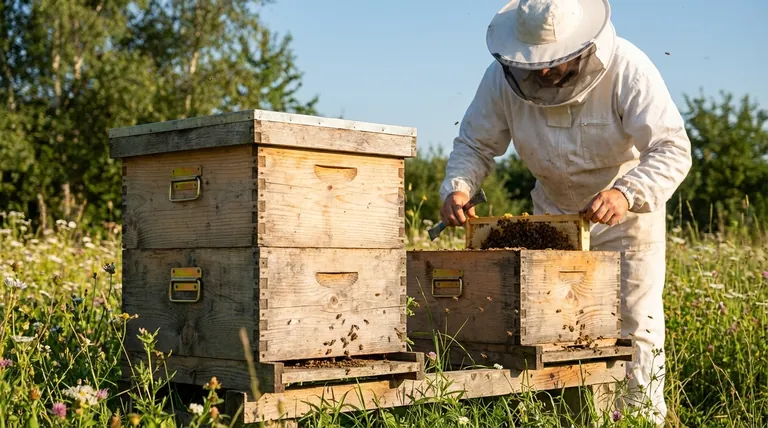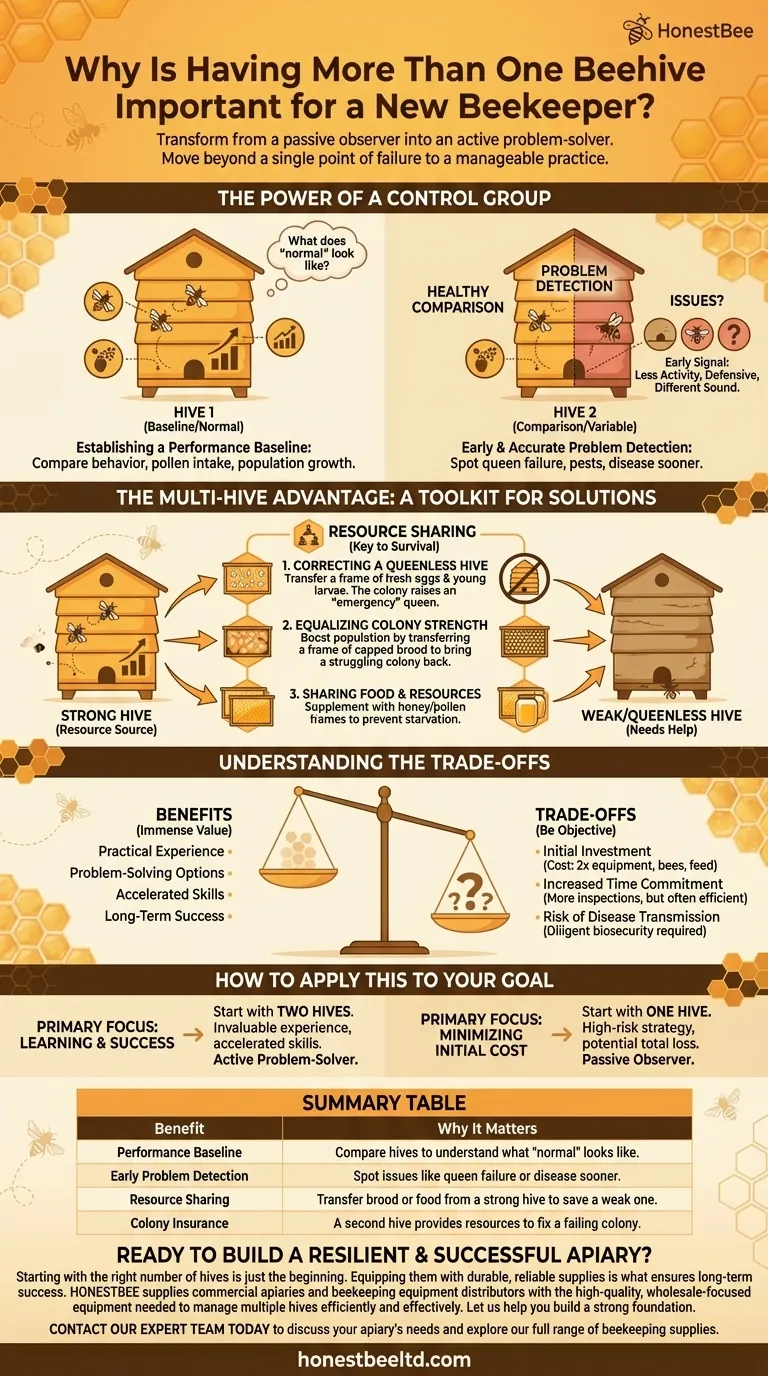For new beekeepers, starting with two hives is the most critical decision for success. While it may seem like double the work, it fundamentally changes the nature of the craft from a high-stakes gamble into a manageable practice. A single hive represents a single point of failure; if the colony dies, your beekeeping season is over before it truly began.
The core reason to manage at least two hives is that it transforms you from a passive observer into an active problem-solver. It provides the resources, comparison, and insurance necessary to navigate the inevitable challenges of the first year.

The Power of a Control Group
The greatest challenge for a new beekeeper is simply not knowing what "normal" looks like. Having two hives running side-by-side provides an immediate, real-time baseline for comparison and learning.
Establishing a Performance Baseline
With only one colony, you have no context for its behavior. Is it bringing in a lot of pollen? Is the population growing quickly enough? You have no way to know if your hive is thriving or struggling.
When you have two hives, you can compare them directly. This helps you identify the stronger, more productive colony and understand what successful development looks like.
Early and Accurate Problem Detection
If one hive is suddenly less active, defensive, or has a different sound than its neighbor, you have an immediate signal that something may be wrong.
This comparative insight allows you to investigate issues like queen failure, pests, or disease much earlier than you would with a single, isolated colony.
The Multi-Hive Advantage: A Toolkit for Solutions
Beyond simple comparison, having multiple hives gives you the ability to share resources between them. This is the key to solving problems that would otherwise be fatal to a single colony.
Correcting a Queenless Hive
The most common and devastating issue for a new hive is losing its queen. A single, queenless hive is doomed.
With a second, healthy hive, you can transfer a frame containing fresh eggs and young larvae. The queenless colony can then use these resources to raise a new "emergency" queen and save itself.
Equalizing Colony Strength
It's common for one colony to be significantly stronger than another. A weak hive may struggle to build up, defend itself, or survive the winter.
You can take a frame of capped brood (developing bees) from your strong hive and give it to the weak one. This provides a massive population boost and can bring the struggling colony back from the brink.
Sharing Food and Resources
If one hive is low on honey or pollen stores, you can supplement it with frames from your stronger hive. This prevents starvation and ensures both colonies have what they need to thrive.
Understanding the Trade-offs
While the benefits are immense, it's important to be objective about the downsides of starting with more than one hive.
The Initial Investment
The most obvious trade-off is cost. You will need to purchase two sets of hive equipment, two packages of bees, and potentially more feed.
Increased Time Commitment
Managing two hives will require more of your time for inspections and maintenance. However, the work is rarely double, as many tasks can be performed efficiently one after another.
Risk of Disease Transmission
Working between two hives requires diligent biosecurity. You must be careful to clean your tools and not transfer frames if you suspect one hive has a pest or disease issue, as you could inadvertently spread the problem.
How to Apply This to Your Goal
Your starting number of hives depends entirely on your primary objective as a beekeeper.
- If your primary focus is learning and long-term success: Start with two hives. The practical experience and problem-solving options it provides are invaluable and will accelerate your skills dramatically.
- If your primary focus is minimizing initial cost: Understand that starting with one hive is a high-risk strategy that often results in the total loss of your investment and a discouraging end to your first season.
Ultimately, two hives provide the flexibility and insight needed to overcome challenges and truly learn the art of beekeeping.
Summary Table:
| Benefit | Why It Matters |
|---|---|
| Performance Baseline | Compare hives to understand what 'normal' looks like. |
| Early Problem Detection | Spot issues like queen failure or disease sooner. |
| Resource Sharing | Transfer brood or food from a strong hive to save a weak one. |
| Colony Insurance | A second hive provides resources to fix a failing colony. |
Ready to build a resilient and successful apiary?
Starting with the right number of hives is just the beginning. Equipping them with durable, reliable supplies is what ensures long-term success. At HONESTBEE, we supply commercial apiaries and beekeeping equipment distributors with the high-quality, wholesale-focused equipment needed to manage multiple hives efficiently and effectively.
Let us help you build a strong foundation. Contact our expert team today to discuss your apiary's needs and explore our full range of beekeeping supplies.
Visual Guide

Related Products
- Professional Drop-Style Hive Handles for Beekeeping
- Professional Galvanized Hive Strap with Secure Locking Buckle for Beekeeping
- Heavy-Duty Nylon Beehive Hive Strap with Stainless Steel Cinch Buckle
- Versatile Ratchet Hive Strap with S-Hooks for Secure Fastening
- 5 Frame Wooden Nuc Box for Beekeeping
People Also Ask
- What makes polyurethane foam environmentally friendly? The Surprising Benefits of a Durable, Inert Material
- What parts of bee equipment should be painted? A Guide to Protecting Your Hive and Your Bees
- Why are hive tools painted in bright colors? Prevent Losing Your Essential Beekeeping Gear
- What is beekeeping equipment? Essential Tools for Commercial Apiaries & Distributors
- What is the role of gloves in beekeeping, especially for beginners? Build Confidence & Safety



















